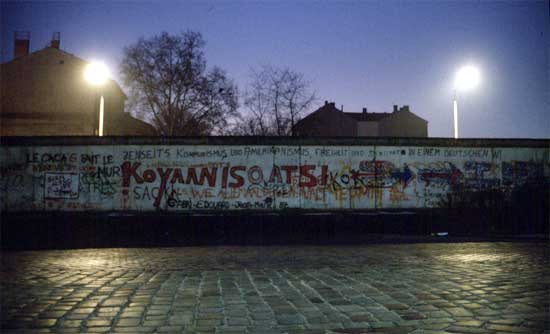Named and Certified as "Peace, From a piece of the Berlin Wall, Seal" by Urasenke XV, Iemoto SEN Soshitsu |
|
The photo was composed by putting a lid rest, which is one of the tea-utensils that were made with clay of the fragment of the Wall in the front and Brandenburg Gate in the background. I have received cooperation of two photographers to make this photograph. The original photograph was from "The Berlin Wall" of Mr. Takahisa Matsuura. I borrowed it and made to emboss it. I asked an instruction of composite photograph to Mr. Hideo Muraoka, who is a senior in the Internet and a professional photographer. Although the photograph of every lid was made, a clipping did not work. I asked a help to the senior and it succeeded happily! That is, this photograph was made by collaboration of three persons. Well, let's begin to talk deliberately... In the 50 years since the end of World War II or I would say almost in the 60 years, a period without a war had never last that long before in Japan. Misery of the World War comes up to my hurt in summer every year. Germany and Japan, which are the same defeated nation... The atomic bomb dropped to this country because it was a colored race. What was the tragedy that was equal to it if Germany had one? Wasn't it the division Germany to east-and-west ? The Berlin Wall construction started in August 1961 and the Wall has been opened in 1989. It is arrival of the Unified of Germany at last. It is thought that the country and people there had sad days for about 30 years. In the meantime, Japan was peace in a certain meaning at least. A Catholic's sister brought a fragment of the Wall after the Wall was released into Japan. A lid read that is one of utensils for the tea ceremony was made with the fragment by a ceramic artist. Furthermore, Konnichian grand master named and certified it as "Peace", and it received an honor. I think that the idea to make a utensil from a fragment of the Wall was rom the master of the tea ceremony. Here are the towns in Kyoto, the world of the tea ceremony and the blessed time for people... It is may pleasure if you look at all these till the end comfortably. |
|
 |
|
Takahisa Matsuura "The Berlin Wall Pictures" Brandenburg GateIt was the symbol of the division Germany then and the symbol of the Unified of Germany now.As it is a famous tourist attraction point, tourists always visited there. As East Germany knew it, the Wall was built lower only right front of the Gate so that people could see it easily from the West Berlin side. |
|
|
I requested Mr. Matsuura a photograph of self-recommendation, and I received the photo and his mail shown below. |
|
 |
|
| @ This is the Wall built along the Bernauer Street. Before the Wall was build, there had been apartments along the road. When East Germany closed the border in order to build the Wall, many people jumped from those apartments to the road on this side to escape to the West Berlin. The wall of those building was exactly on the border of the East-West Berlin. People and firefighters prepared mattresses on the road to help jumping people in the West Berlin side, but some of them missed those mattresses, landed directly on the road and died. In order to block the exile by jumping, the East Germany authority closed every single window with blocks and the buildings became spooky ghost town appearance. When they build the Wall later, those apartments were demolished down. ThereforeBernaue Street became famous and many tourists visit here. I think some Japanese also visited there. Takahisa Matsuura |
|
The lid rest in the photo is about twice as large as the original size. Since the wall was made of cement, the textured surface is because fragments were mixed in. Mr. Tokusen Nishimura, a ceramic artist, who lives in Kyoto, made this. He told that it was difficult to make as broken concrete pieces were mixed in. I've never thought to make utensils for tea ceremony with materials by breaking fragments to pieces. h had a chance to make the acquaintance of a famous priest in training, who lived at a small temple in Myoshinji over 30 years ago, and I received a tea bowl. It was a tea bowl made with sands from Nirenzen River of the northern part of India. A doctor names it and wrote, "Visited Buddhist temple ruins. With sands from Nirenzen River. Name: Nirenzenga" I have offered a cup of tea to a Catholic's sister with the tea bowl. Well, I will start telling with the friendship between the sister and myself. One day, the sister handed a package to me and told. "I asked strongly to an acquaintance to make a utensil like this. Please use it if you can." The Sister told me that a German Sister brought the fragment of the Wall to Japan, and she received it. The idea to make a tea utensil with it came up to her and she requested to make a tea bowl and a lid rest with it to a ceramic artist. Is this okay? I have become to keep one of them in my hand again. |
|
The Sister visited me for practice for a while. We had chats and I let her find join the tea ceremony. She was enthused by absorbing a lot. Photo when she helped in a preparation room at a tea ceremony. Alcove in a waiting room and picture of persimmon. |
Thick tea in the winter The lid rest here is made in Netherlands. She wore for practice. |
Students of Sister who was a teacher at the time. When I presented dolls for Girls' Festival, she sent this photo thanking me. field mustard, peach flowers and lovely children. Girls' Festival, which was small, however was filled with the heart. Kyoto fortunately escaped from damages during the War, and old flavors are floating all over the town. I walked along Sanjo from Oike on July 17, a pre-festival of the Gion festival and went to Muromachi to see Byobu festival. Young girls happened to wear Yukata and they were so lovely. I saw several potable shrines but I took only this photo. |
|
They open their house, display screens treasured by the family and make arrangements in order to let people see them from the street. It is pride of Hoko-machi that always values not only status of families but also the traditions of Kyoto. I walk and am impressed every year as what a wonderful festival this is! The framed calligraphy means that luxuriating does not last long. The layout of the house is, as you know, long narrow style. Therefore it is cool as the wind blows through. Then, the lid rest come up here. I will explain from the practice room of Urasenke Konnichian. |
|
A lid rest is carried out first in a wastewater receptacle called as "Kensui". A bamboo ladle sits on it straight. Kensui is a utensil to pour off the water. There is a similar utensil in the Chinese dishes to keep bones. It may not similar though it is resemble in the shape. As it is the place where a clean lid read sits. |
|
Dry sweets,@rice cracker, and rakugan |
|
Take the lid rest out of Kensuo, and put the ladle on it. It serves as a rest for the ladle. |
|
Next, open the lid of the kettle and put it on the lid rest. It also serves as a rest to put linen cloth on it. It has important rolls, though it is small! |
|
Mr. Sokyu Tsuchimoto, a senior Urasenke deputy tea masters is a master not only in the tea ceremony but also photography. I brought the lid rest made with a piece of the Berlin Wall and he approved me to use it. But, he suddenly changed from an instructor to a cameraperson, saying "Photo shooting is prohibited here." It was a totally unexpected incident. However, the camera was my favorite Contax. He did not only push the shutter. But, he tried to hide an old person as a subject. Oh, I appreciate from the heart. |
|
There are more than one way to put up a ladle and a lid rest. He arranged to take pictures with two different ways to put them up. |
|
In Yari room Flowers: lilies. Hanging vase: Bezen. Brazier: chamfered. Kettle: Mashiroya. Shelves: Tantansai favorite. Water jar: Annan shibori. Tea container: Red. Lid rest: Berlin Wall. |
|
In Hosensai room Shelves: Tantansai favorite. Water jar: Koshi araiso by Eiraku Tea container: Rikyu style by Sotetsu. Lid rest: Boxed and named by Hounsai Iemoto. Peace, Berlin Wall. |
|
Tatami corridor run to Rikyudo. The heat in Kyoto around 36 degrees is the same as today. It is the world without air conditioning. Just follow the teaching. Thinking it, it was wonderful encounter. It came from far away from Berlin to Kyoto. We may have an additional benefit out of it. The cool wind breeze through here. Pardon? Where is the lid rest? Well! I am sorry, but I brought it back home quickly (laugh). |
|